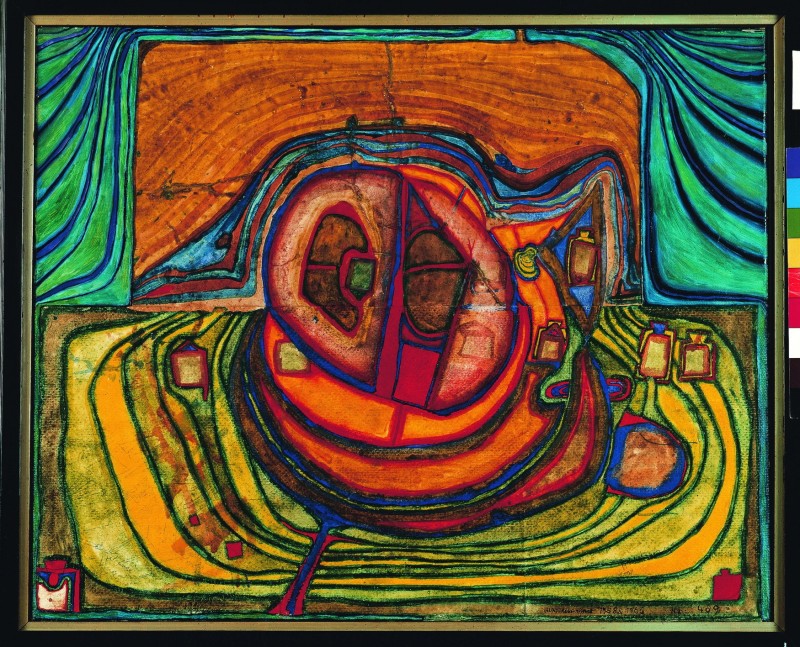409
DAS HERZ DER REVOLUTION
The Heart of the Revolution
formerly: The Two Semi-Circles
formerly: The Two Semi-Circles
autrefois: LES DEUX DEMI CERCLES
Hamburg, 1963
Painted in Paris, 1958 - Hamburg, at Poppe`s house in Fuhlsbüttel, June 1963
455 mm x 560 mm
Watercolour on two pieces of paper, watercolour paper and wrapping paper; mounted on canvas with PV in 1963 and finished with watercolour and oil; priming in chalk and PV, varnished with wax
Sammlung Würth, Künzelsau, Germany
- Galerie Raymond Cordier, Paris, 1960
- *
- Travelling exhibition 1964/65:
- Kestner-Gesellschaft, Hanover, 1964
- Kunsthalle Bern, 1964
- Karl-Ernst-Osthaus-Museum, Hagen, 1964
- Stedelijk Museum, Amsterdam, 1964
- Moderna Museet, Stockholm, 1965
- Museum des 20. Jahrhunderts, Vienna, 1965
- *
- World Travelling Museum Exhibition:
- Museo Español de Arte Contemporáneo, Madrid, 1979
- Seedamm-Kulturzentrum, Pfäffikon/Lake Zurich, 1979
- Palazzo Barberini, Rome, 1980
- Palazzo Reale, Milan, 1980
- Henie/Onstad Stiftelser Kunstsentret, Høvikodden,1980
- Museum Ludwig, Cologne, 1980/81
- Secession, Vienna, 1981
- *
- Institut Mathildenhöhe, Darmstadt, 1998
- Toskanische Säulenhalle im Zeughaus, Augsburg, 2002
- *
- Würth Exhibitions 2004-07:
- Kunstlocatie Würth, MK`s-Hertogenbosch, 2004/05
- Art-Room-Würth, Böheimkirchen, 2005
- Kulturforum Würth, Chur, 2005/06
- Galleri Würth, Hagan, 2006
- Kulturforum Würth, Kolding, 2006/07
- *
- Art Forum Würth, Capena/Rome, 2008
- KunstHausWien, Vienna, 2008/09
- Sparkasse Academy, Bozen, 2010/11
- Kunstlocatie Würth 's-Hertogenbosch, 2011/12
- Österreichische Galerie Belvedere, Orangerie, Vienna, 2013
- Cobra Museum, Amstelveen, 2013/14
- Forum Würth Arlesheim, Switzerland, 2014-17
- 100 works on paper, Boston, 1959
- Labyrinthe, Akademie der Künste, Berlin, 1966
- W. Schmied, Hundertwasser, Feldafing, 1964 and ed. 1973, pp. 15 (c), 45
- Hundertwasser - Was braucht der Mensch um glücklich zu sein?, Munich, 2002, p. 31 (c)
- A. C. Fürst, Hundertwasser 1928-2000, Catalogue Raisonné, Cologne, 2002, Vol. II, pp. 379/380 (and c)
- Hundertwasser - Wenn einer alleine träumt..., Munich, 2003, p. 41 (c)
- Kestner-Gesellschaft, Hanover, 1964, pp. 26 (c), 206
- Moderna Museet, Stockholm, 1964, cat. 101
- Museum des 20. Jahrhunderts, Vienna, 1965, cat. 78
- Museo Español de Arte Contemporáneo, Madrid, 1979, cat. 171
- Museum Ludwig, Cologne, 1980, p. 211 (c)
- Secession, Vienna, 1981, p. 211 (c)
- Kulturhaus, Graz, 1981, p. 211 (c)
- Institut Mathildenhöhe, Darmstadt, 1998, p. 71 (c)
- Toskanische Säulenhalle im Zeughaus, Augsburg, 2002, p. 17 (c)
- Leaflet, Toskanische Säulenhalle im Zeughaus, Augsburg, 2002 (c)
- Leaflet, Galleri Würth, Hagan, 2004/05 (c)
- Der unbekannte Hundertwasser, KunstHausWien, Vienna, 2008, pp. 96 (and c), 288
- La raccolta dei sogni, Art Forum Würth, Capena (Rome), 2008, p. 73 (c)
- Sparkasse Academy, Bozen, 2010/11, pp. 26-27 (and c)
- HW-Die Kunst des grünen Weges, KunstHausWien, Vienna, 2011, pp. 126 (c), 214
- Hundertwasser, Japan und die Avantgarde, Österreichische Galerie Belvedere, Orangerie, Vienna, 2013, p. 50 (c)
- Würth - Eine Sammlung, Sigmaringen, 1991, p. 52 (c)
- S. Wille, Träume sind große Taten, Vienna, 1993, p. 9 (c)
- Hundertwasser Bibel, Augsburg, 1995, NT, p. 144 (adaptation, c)
- Postcard, Buchheim Verlag, Feldafing, n.d. (repr.)
- Art Calendar 1972, Buchheim Verlag, Feldafing (postcardsize, September)
- Art Calendar 1974, Buchheim Verlag, Feldafing (32 x 40 cm, May)
- Hundertwasser Art Calendar 1987, B. Wörner, Rutesheim (July)
- Hundertwasser 2004 Calendar, Taschen, Cologne (and reprints)
- Calendar, Hundertwasser 2011, Südtiroler Sparkasse AG, Bozen
- Hundertwasser 2012 Calendar, Taschen, Cologne (and reprints)
- Leaflet, Forum Würth, Arlesheim, 2014 (c)

Hundertwasser's comment on the work
Originally the painting was two watercolours, two parts: an upper and a lower part. I put them together and sold them to a collector in Hamburg. It was not a particularly beautiful picture until I finished painting it later, the way it is shown here. After it was finished, I thought a long time about the name and finally came up with The Heart of the Revolution. By that I did not mean a wild revolution, but one which slowly spreads, kind of a vegetative revolution, a kind of evolution. I can leave a painting untouched for years, often three, four, five years, and suddenly I finish it. This is a painting I am particularly fond of. I think the title is a good choice. It really is a heart that is beating. Unfortunately the technique cannot be made out in the colour reproduction. The picture is painted partly with water technique and partly in oil. The result is that parts of the painting are matte and others shiny. That gives the painting a fascination of its own, by virtue of the contrast, not just that of complementary colours such as red and green, but also the contrast of matte and shiny surfaces. That, I think, is a specialty of mine. (from: Hundertwasser, Buchheim Verlag, Feldafing, 1964 and ed. 1973, p. 14)